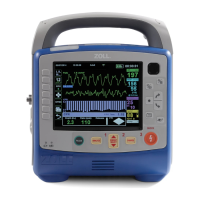Configuring NIBP Alarms and Settings
9650-001355-01 Rev. M X Series Operator’s Guide 8-11
Configuring NIBP Alarms and Settings
The last step in preparing to perform NIBP measurements is to ensure that the necessary alarms
are enabled (or disabled), that alarm limits are appropriate, and that the NIBP settings are
correct.
Enabling/Disabling NIBP Alarms and Setting Alarm Limits
When enabled, the X Series unit sounds alarms whenever measurements are outside set limits
for the following:
• High and Low Systolic Pressure
• High and Low Diastolic Pressure
• High and Low Mean Arterial Pressure (MAP)
To enable (or disable) NIBP alarms and set upper and lower alarm limits, you can do so through
the Alarms quick access key ( ) or the NIBP Parameter Control Panel.
To configure NIBP alarm limits through the Alarms quick access key:
1. Press the More quick access key ( ).
2. Press the Alarms quick access key ( ).
3. Press the Limits quick access key ( ).
4. Use the navigation keys to highlight and select the appropriate alarm menu selection. For
NIBP, the alarm menu selections are NIBP Systolic Alarm, NIBP Diastolic Alarm, and
NIBP MAP Alarm.
5. On the selected NIBP alarm settings menu, use the navigation keys to select the fields that
you want to change. The fields are
• Upper Limit Enable
• Lower Limit Enable
• Upper Limit
• Lower Limit
6. When you are finished changing values on the alarm settings menu, select the back arrow to
exit the menu.
Setting Upper and Lower Systolic Alarm Limits
Initially, the NIBP Systolic Alarm Settings menu specifies that the NIBP systolic pressure
alarms are enabled (
ON) or disabled (OFF), and displays the default upper and lower systolic
limits. The upper and lower limits can be
ON or OFF (default is OFF). The following table lists
the default NIBP Systolic limits for adult, pediatric, and neonate patients, and gives the range in
which you can set these limits:
Patient Type NIBP Systolic Limit Default NIBP Systolic Limit Range
Adult Lower: 75 mmHg
Upper: 220 mmHg
Lower: 30-258 mmHg
Upper: 32-260 mmHg
Pediatric Lower: 75 mmHg
Upper: 145 mmHg
Lower: 30-158 mmHg
Upper: 32-160 mmHg
Neonate Lower: 50 mmHg
Upper: 100 mmHg
Lower: 20-118 mmHg
Upper: 22-120 mmHg

